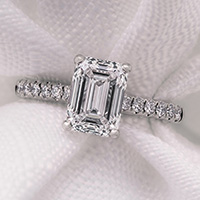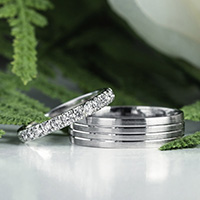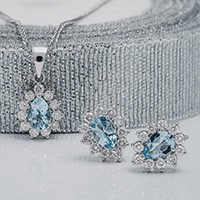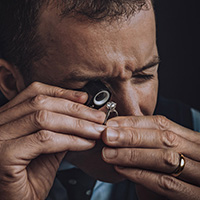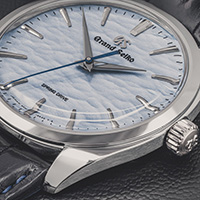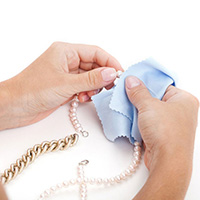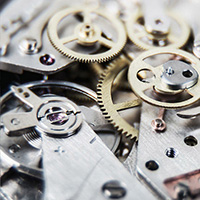Exquisite Emerald: The May Birthstone
Emerald, the Birthstone for May is one of the ‘big four’ precious gemstones alongside Diamond, Ruby, and Sapphire. Prized for its vivid green colour, Emerald is the favoured gemstone of iconic women throughout history. From Cleopatra to Elizabeth Taylor and more recently Angelina Jolie, Emerald jewellery makes a bold statement. Indeed, in the introduction to the book Emerald, US jewellery writer Hettie Judah states:-
“Girls can wear pearls, but it takes a woman to wear serious emeralds.”
Emerald Facts
- The word “’emerald” comes from the Greek smaragdus meaning “green”
- Like Aquamarine, Emerald is a beryl gemstone
- Emerald gets its green colouring from trace amounts of chromium and/or vanadium
- It is the birthstone for May and the 55th Wedding Anniversary
- Emeralds are popular for May engagements and weddings and to celebrate the birth of a baby
- In North America, Emerald beats both sapphires and rubies as the most in demand coloured gemstone
- The U.S. and Japan are the world’s biggest consumers of emeralds, purchasing more than 75% of the world’s cut emerald gemstones
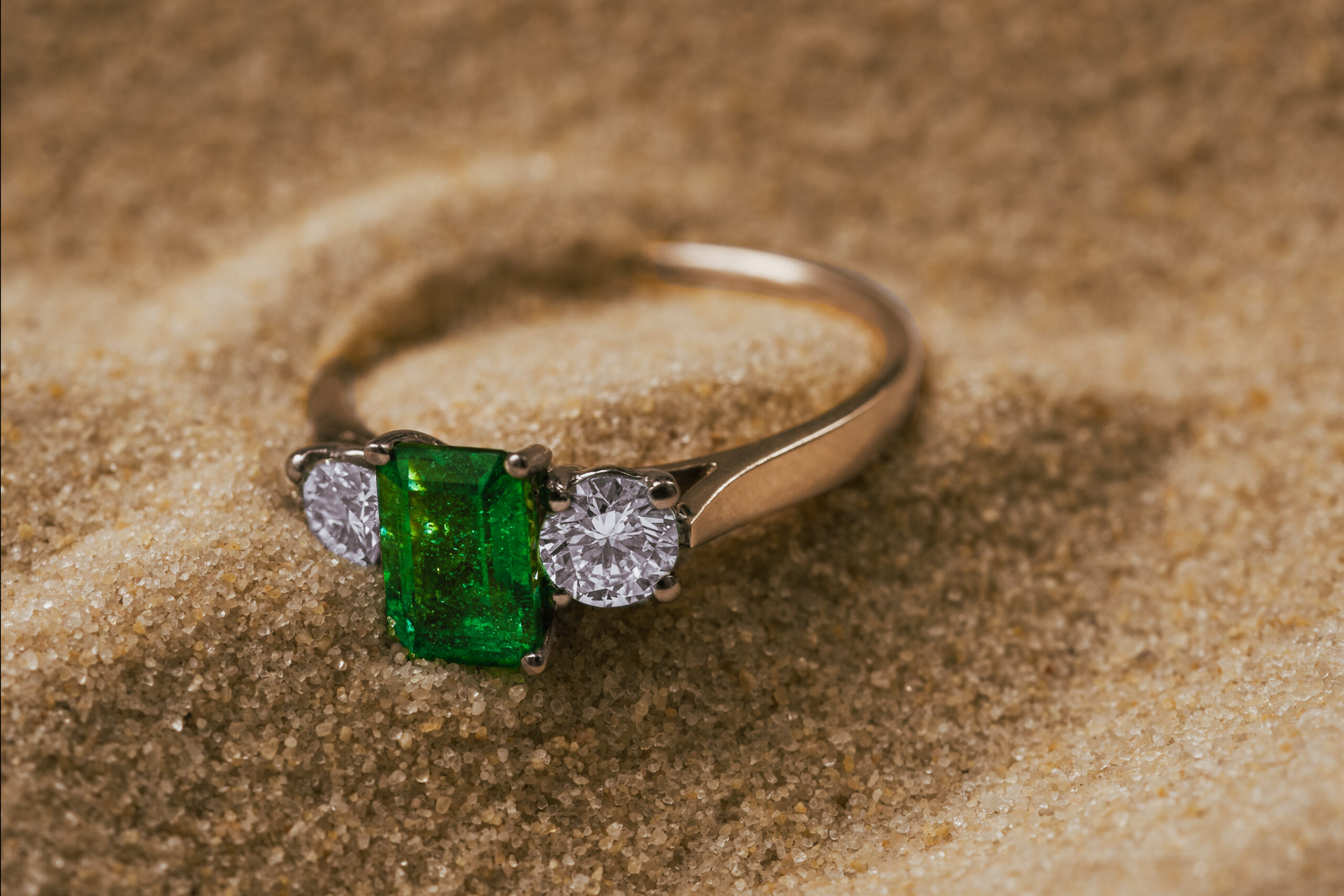
Emerald cut three stone with round brilliant cut diamonds in a yellow gold band.
Properties of Emerald: Hardness and Colour
Emerald measures between 7.5 to 8 on the Mohs Scale of hardness.
However, although emerald is a hard gemstone, it is prone to cracking and chipping. Emerald is virtually always included to some degree. Inclusions occur when the emerald forms in the earth. Moreover, they reduce the structural integrity of the stone, making it more fragile. Consequently, emeralds can be expensive to set in jewellery due to the risk of damage.
The best colour for an emerald is vivid/blueish green with even saturation and no colour zoning.
Where and How is Emerald mined?
South America is the centre of the world’s emerald mining. Due to is unique geology, Colombia is the major producer, accounting for 50% of the world’s emeralds.
The second largest producer is Africa with emerald mines in Zambia, Zimbabwe, Nigeria, and Madagascar. Interestingly, each mine produces a certain colour, size, and clarity of emerald.
Finally, Colombia is the largest exporter of ethical emeralds with the main mining companies retuning profits to local communities.
Emerald throughout History
The oldest emeralds are approx. 2.97 billion years old with the first known emeralds mined in Egypt around 1500 B.C.
In ancient times, emeralds were seen as symbols of fertility and immortality. Also, they were a sign of power and wealth. Consequently, Cleopatra decorated her palace with emeralds and gave them as gifts to foreign dignitaries.
Throughout history, emeralds have been worn as talismans to prevent memory loss, increase eloquence, and help the wearer see into the future. There was also a widely held belief that emeralds could confer riches and power as well as guard against possession by demons.
Finally, Arab, Hindu, and Spanish physicians used emeralds against poison and infection.

Roman Era Necklace From 1st-2nd Century
Meaning and Symbolism
Emerald symbolises love, springtime, fertility, and new beginnings (think green shoots!).
Famous Emeralds
Emeralds can grow to be very large. In fact, the largest emerald crystal weighs a whopping 16,020 carats!
Weighing 1384 carats, the richly coloured ‘Duke of Devonshire Emerald’ is 51mm long. It is believed to be the largest uncut Colombian emerald in existence. It was given (or sold) to the 6th Duke of Devonshire by Emperor Pedro I of Brazil. He kept it in his private collection for 20 years before publicly displaying it at the Great Exhibition in 1851 at London’s Crystal Palace. It is currently on display at the Natural History Museum in London.
Found in 1967 in the Vega de San Juan mine in Gachalá, Colombia, The Gachalá Emerald has a weight of 858 carats and length of 50mm. It is one of the most valuable emeralds in the world and was donated to the Smithsonian Institution in Washington D.C. by U.S. Jeweller, Harry Winston.
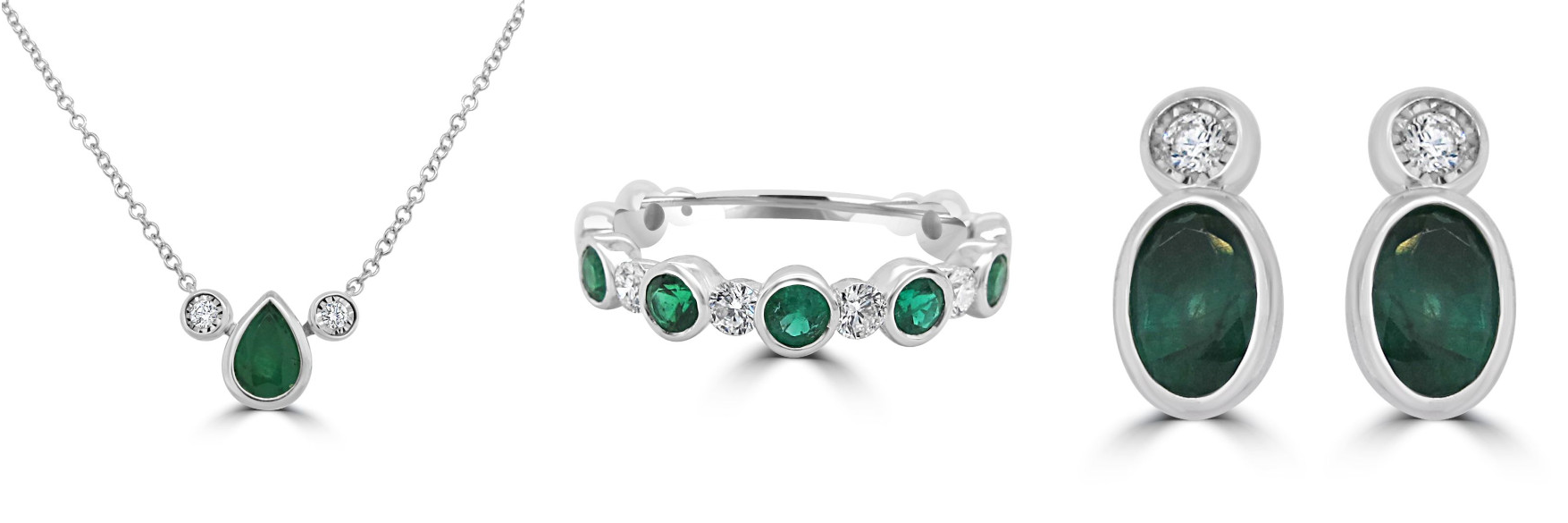
L-R White gold pear cut emerald and diamond necklace - White gold emerald and diamond 'bubble' ring - White gold oval emerald and diamond stud earrings
Emerald: Links to Royalty
Emeralds have been worn by royalty throughout history. Today, they are regularly worn by Queen Elizabeth II, the Duchess of Cornwall, and the Duchess of Cambridge.
Emeralds and Queen Victoria
The Queen Victoria Emerald Tiara is the only tiara designed by a consort for his queen. Designed by Prince Albert in 1845, it is currently on display at Kensington Palace. The tiara complements a necklace formed of nine oval emerald clusters, each set within a border of cushion-shaped diamonds. Albert also gave Victoria an elegant pair of pendant emerald earrings and a stunning 20ct emerald and diamond brooch.
Emeralds and Queen Elizabeth II
Most of the emeralds we see Queen Elizabeth II wearing are derived from The Cambridge Emeralds. The story behind them is fascinating. Won in a state-run lottery in Frankfurt by the Duchess of Cambridge in the early 1800’s, most were incorporated into jewellery. The jewellery and other loose emeralds passed to her daughter Princess Mary Adelaide, Duchess of Teck. Upon her death they were inherited by her son Prince Francis of Teck. Frank did not have a wife so when he died suddenly in 1910, the Cambridge Emeralds almost left the royal family entirely as they were bequeathed to his mistress Nellie! Frank’s sister (who became Queen Mary) was not about to let the Cambridge Emeralds leave the family and found a way to get them back. They have remained in the family ever since.
Emeralds and Princess Diana
Princess Diana’s most famous piece of emerald jewellery, her Art Deco choker also incorporates the Cambridge Emeralds. Created by Garrard in 1921, it originally belonged to Queen Mary who in 1953 bequeathed it to Queen Elizabeth. As the Queen is not a fan of chokers, she gave it to Diana as a wedding gift in 1981. Prince Charles also gave her a pair of matching earrings as a gift for her 22nd birthday. In 1985, Diana famously wore the choker as a headband during a tour of Australia in 1985 with Prince Charles. Over a decade later, she wore the dazzling choker and earrings again at one of her last public appearances before her death. Teamed with a black dress by designer Jacques Azagury, the event at London’s Tate Gallery fell on her 36th birthday.

L-R - Yellow gold emerald and diamond channel set bangle - , Yellow gold emerald and diamond necklace - Emerald and diamond drop earrings
Emeralds on the Red Carpet
Goddesses of the Silver Screen have been enchanting us with emeralds on the red carpet since the Golden Age of Hollywood.
Emeralds and Elizabeth Taylor
Elizabeth Taylor’s jewellery collection is legendary. However, in a case of life imitating art, Richard Burton famously gave her an exquisite suite of Bulgari emeralds while they were filming Cleopatra (Cleopatra, as we know, was famous for wearing emeralds). With 16 Colombian emeralds with a weight of 60.5 carats in the necklace alone, Taylor wore the suite throughout her life. After her death, her jewellery collection was famously auctioned at Christies where her Bulgari Emerald Necklace realised $6,130,500 (bought back by Bulgari).
Emeralds and Angelina Jolie
In more recent years, emerald jewellery has made its way back onto the red carpet in a big way. At the 2009 Academy Awards, Angelina Jolie caused a stir, wearing a dramatic pair of 115-carat pear-shape emerald drop earrings designed in a very simple setting by Lorraine Schwartz.
Emeralds and Beyoncé
Beyoncé is also a huge fan of Lorraine Schwartz, regularly wearing her jewellery ever since the famous ‘Beyoncé earrings’ of her early career. This two tier emerald suite designed by Schwartz, radiates old-Hollywood glamour.
Emeralds and Julianne Moore
Finally, with her beautiful strawberry blonde hair and fair complexion, emeralds have become a signature style for Julianne Moore. She has worn them on the red carpet for many years. However, the 2016 Cannnes Film Festival marked the start of something new. The stunning Chopard earrings worn by Moore were the first sustainable, ecological, and humanely mined emeralds produced by the luxury brand. In response to a ‘Green Carpet Challenge’, Chopard and Moore put ethically produced luxury jewellery firmly in the public arena.
Emerald Buying Guide: How is it graded?
The 4 C’s
Emerald is graded using the ‘4 C’s’ (cut, colour, clarity, and carat). With emerald, the most important of the ‘C’s’ is colour.
Colour
The best colour is vivid green/blueish green with even saturation and no colour zoning
Cut
Cutting an emerald into the optimal shape with the right number of facets can make a difference to the emerald’s colour. The mark of a good cut is an even green colour. Historically emeralds are cut into their namesake ‘emerald cut’ which prevents the emerald breaking. Other cuts such as cushion and oval are also possible but less popular.
Clarity
High quality emeralds are transparent. However, emeralds typically contain inclusions that are visible to the naked eye.
Carat
The price per carat escalates in size. For example, a fine quality 3ct Colombian Emerald is six times more valuable than three 1ct stones of equivalent quality.
Top quality emeralds can be worth more than diamonds on a per carat basis.
How to Care for Emerald: Tips and Handy Hints
- Treat emerald jewellery with care and avoid rough treatment
- Remove emerald rings when doing anything active with your hands
- Never clean emerald in an ultrasonic tank
- Simply immerse in warm water and use a soft brush to gently remove ingrained dirt. Remove excess liquid and allow to air dry. Gently polish with a soft lint-free cloth
- Coating emeralds with a little baby oil can help prevent them becoming overly brittle
Emerald at James Porter & Son
When buying emerald jewellery, it’s very important to buy from a reputable jeweller.
Here at James Porter & Son, we are a fifth-generation family business with over 160 years of expertise handed down from father to son. Our director Simon Porter personally selects every piece of emerald jewellery in our store, for its quality and design.
Browse our collection of stunning Emerald jewellery online or visit one of our boutiques in Glasgow’s famous Argyll Arcade.
If you have any questions about Emerald, please do contact us.
 Basket
Basket

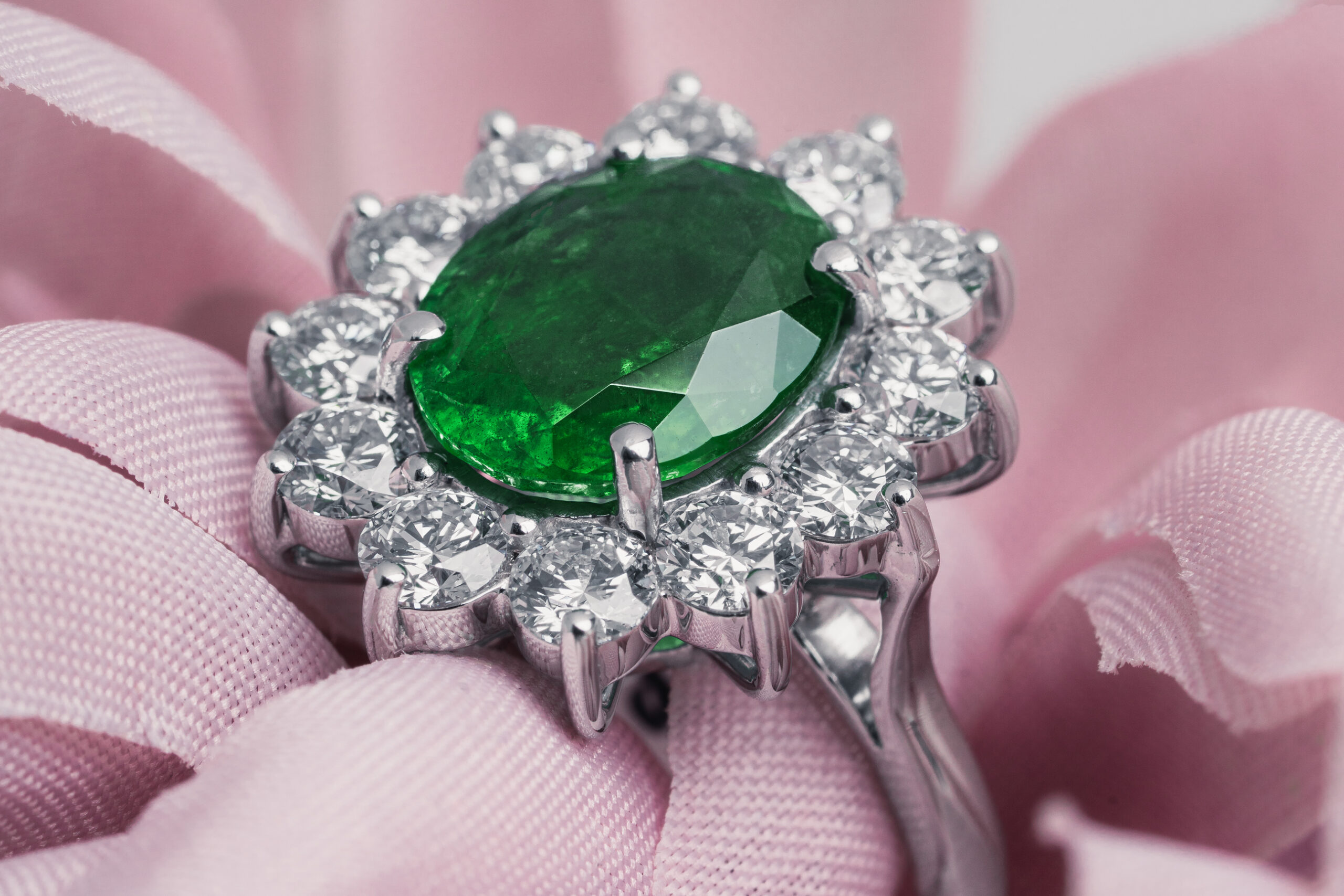
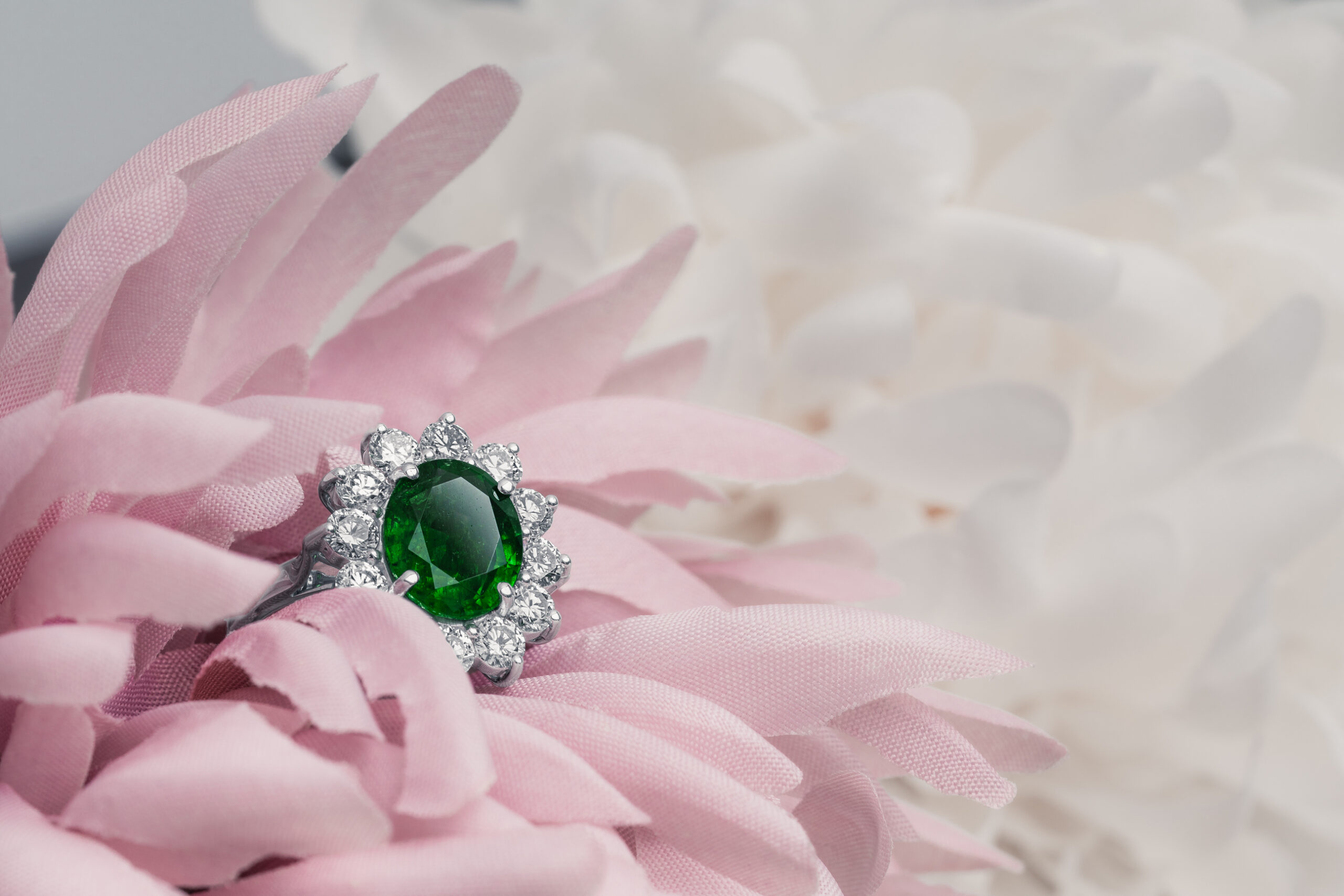





 Back to top
Back to top 0141 221 5855
0141 221 5855 Send us an email
Send us an email
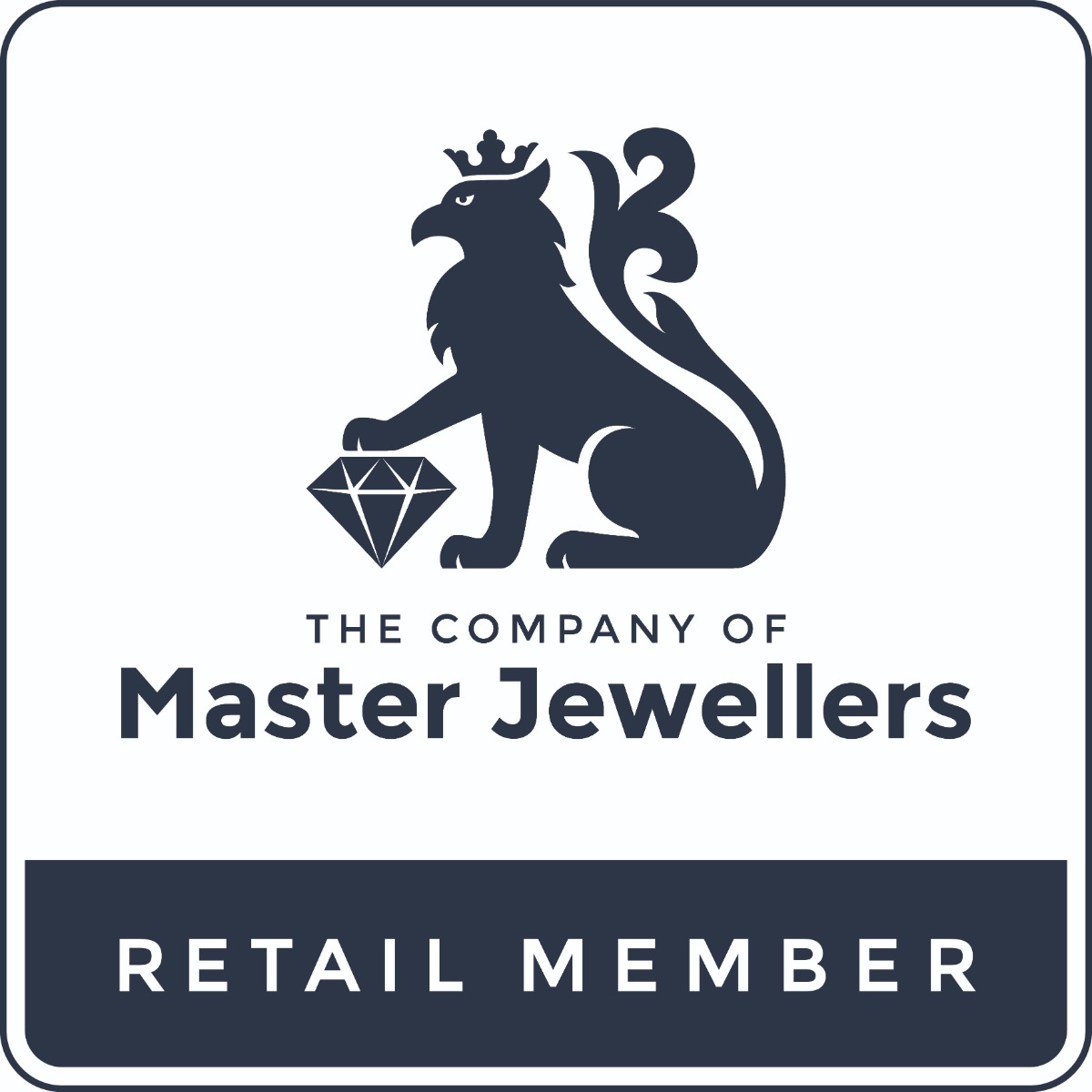





 Secure payment methods
Secure payment methods


